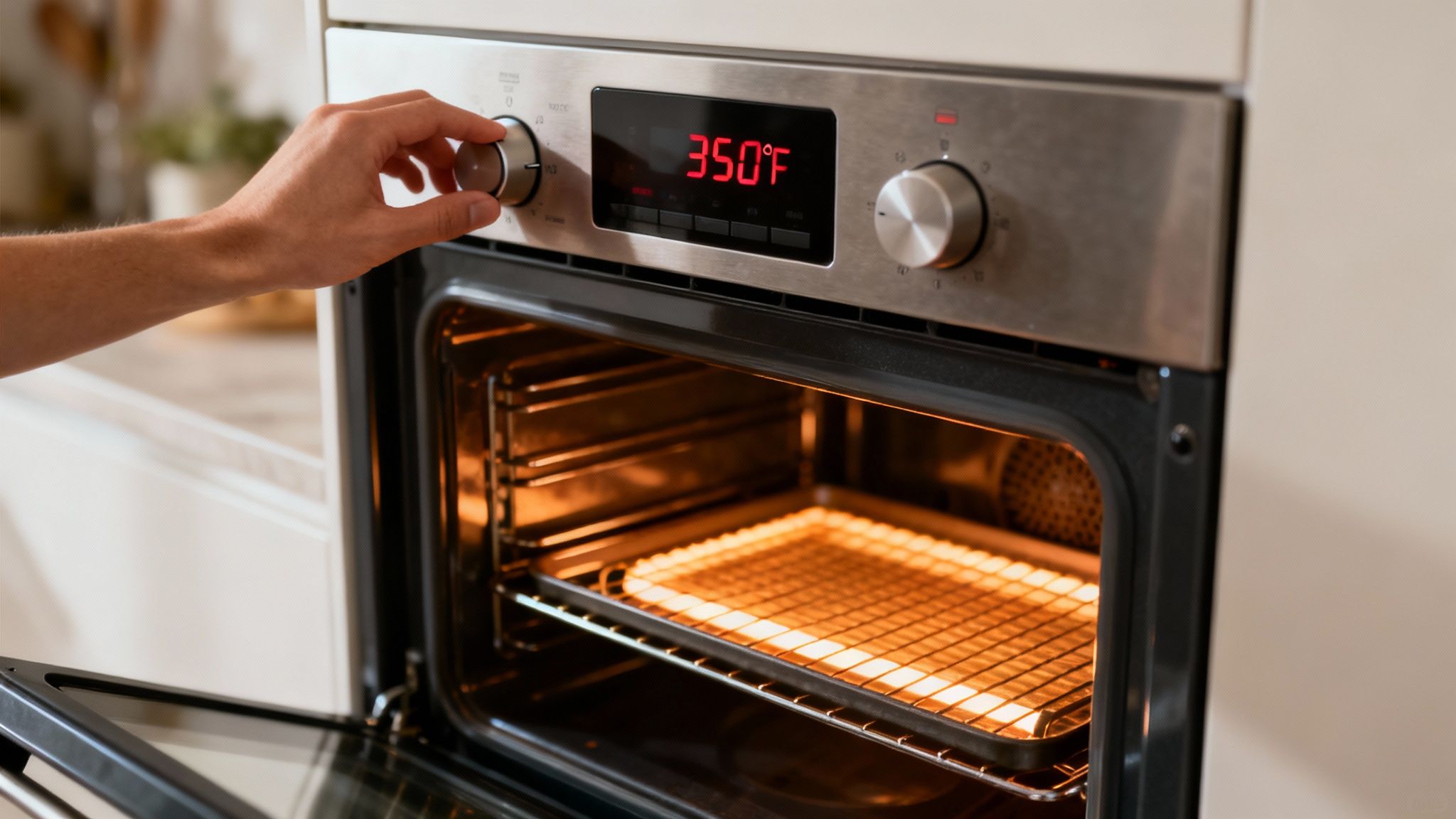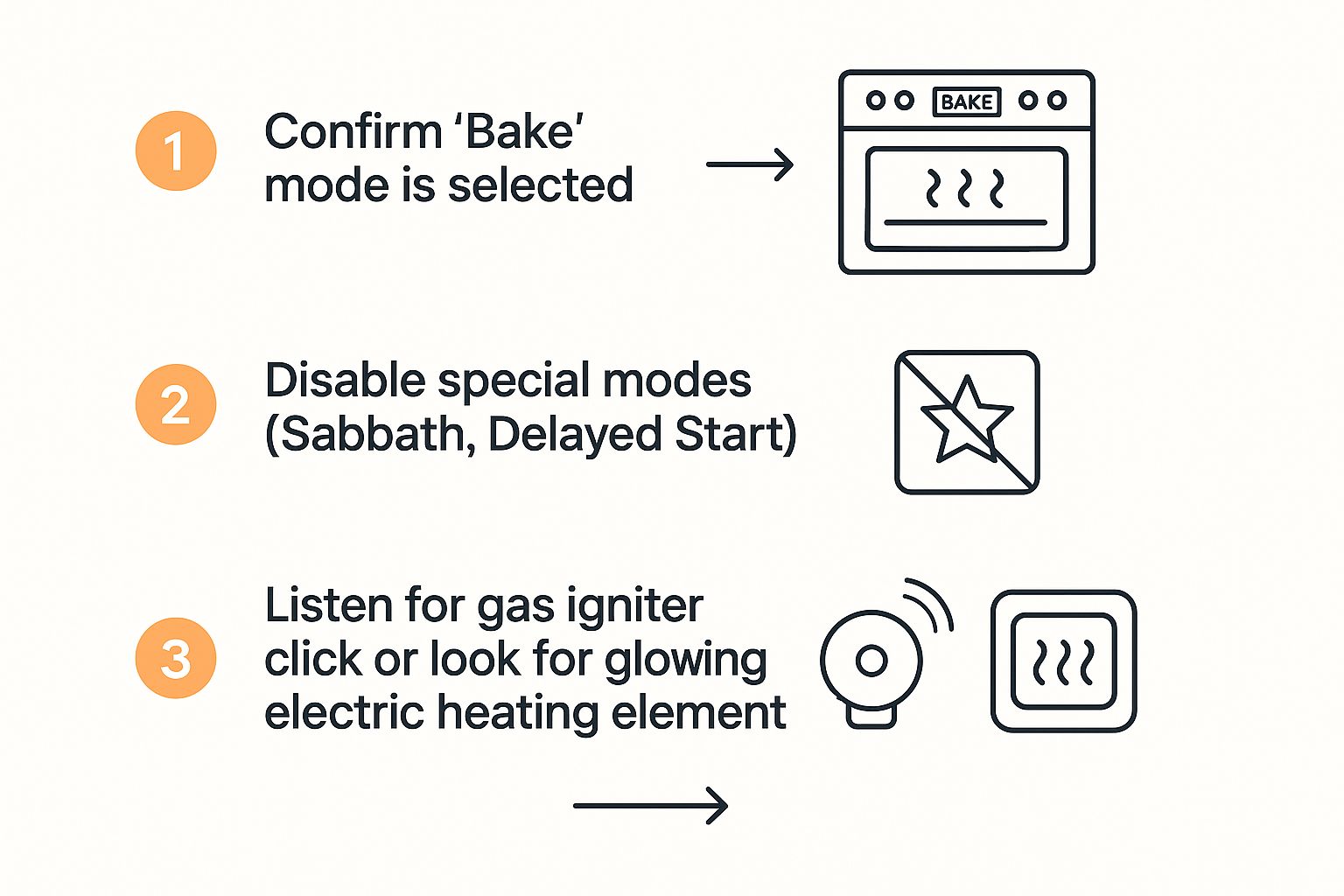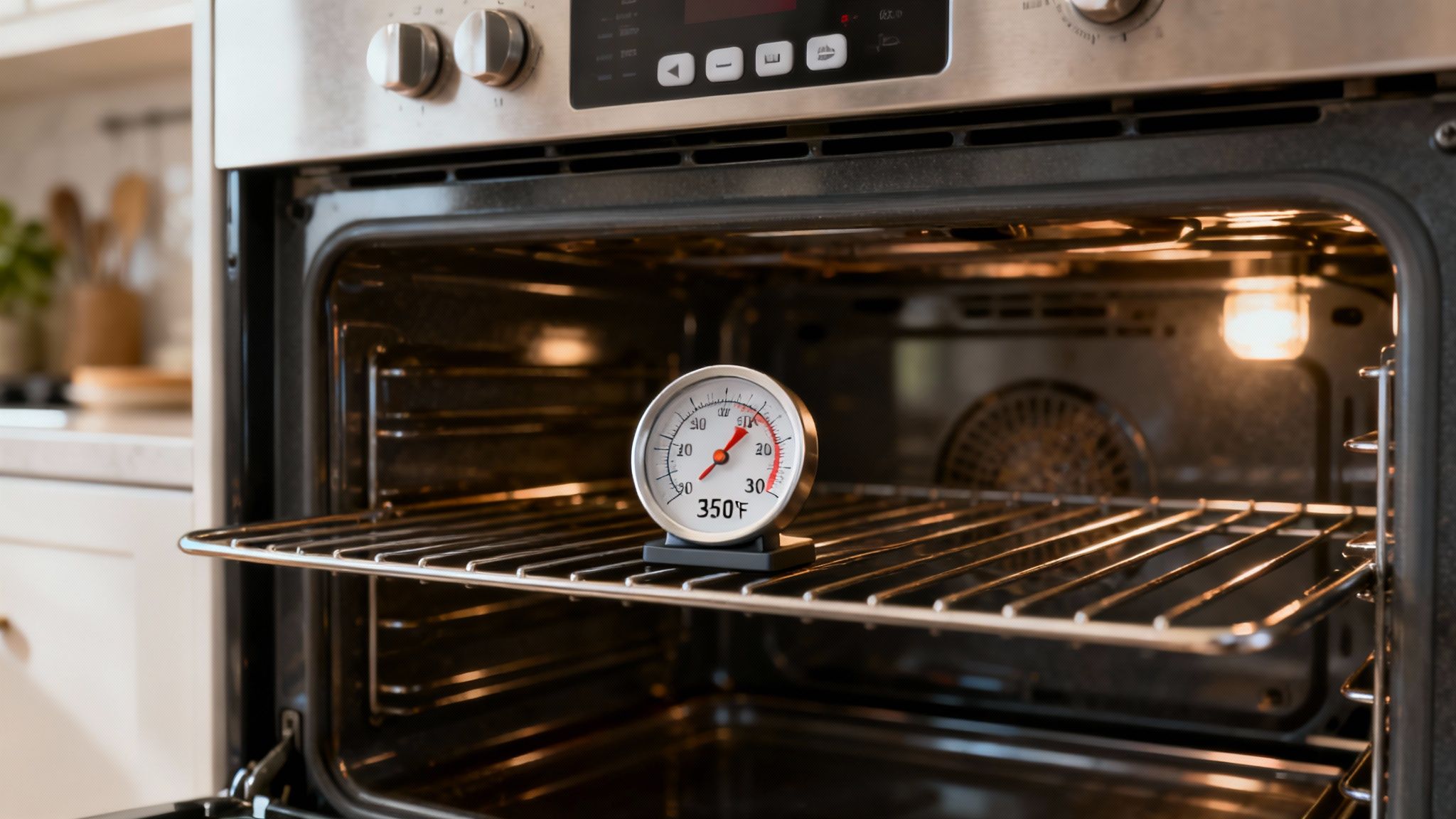You’ve got dinner prepped, the family is hungry, and you open the oven to find it’s still cold. It's a frustrating moment we've all been through. When an oven won't heat to the right temperature, the problem usually traces back to one of a few key parts. For most folks with a gas oven in areas like Plano or Frisco, the prime suspect is a faulty igniter, while a dead heating element is the common culprit in electric models.
Why Your Oven Won't Heat Up Properly in the Plano Area
Let’s get to the bottom of this. You set the oven to preheat, come back 15 minutes later, and it's barely warm. Before you panic, it's helpful to understand that your oven is a system. When one component gives out, the whole heating process can grind to a halt. We'll walk through the most common issues so you can figure out what’s going on with your appliance, whether you're in McKinney or anywhere in North Dallas.

Sometimes, the fix is straightforward and something you can handle yourself. Other times, a specific part has simply worn out and needs replacing.
Common Culprits Behind a Cold Oven in Frisco and Allen
So, what’s actually stopping your oven from getting hot? Here are the usual suspects I see on service calls time and time again across Frisco and Allen.
-
Failed Igniter (Gas Ovens): This is, without a doubt, the #1 reason a gas oven fails to heat. The igniter's job is to get hot enough to signal the gas valve to open. If it's weak and doesn't draw enough power, the valve stays shut, no gas flows, and you get zero heat. It’s that simple.
-
Burnt-Out Heating Element (Electric Ovens): Your electric oven has two workhorses: the bake element on the bottom and the broil element on top. Over years of use, they can blister, crack, or just break. You'll often see visible damage, or it might just fail to glow that familiar bright red.
-
Malfunctioning Temperature Sensor: This little probe acts as the oven's internal thermometer. If it's on the fritz or has been knocked against the oven wall, it can send wild readings to the main control board. The oven might think it's already at 350°F when it's only 150°F, causing it to shut the heat off way too soon.
To help you narrow things down, I've put together a quick reference table. Match your oven's behavior to the likely cause.
Quick Guide to Oven Heating Failures for North Dallas Residents
Use this table to quickly match your oven's symptoms to the most likely cause and see if it's a potential DIY fix.
| Symptom | Potential Cause | DIY Feasibility |
|---|---|---|
| Gas oven won't light at all, no glow from igniter. | Faulty Igniter | High. A common and manageable replacement for DIYers. |
| Electric oven isn't heating, bake element is dark. | Burnt-Out Bake Element | High. Usually just a few screws to replace. |
| Oven heats up, but temperature is way off. | Malfunctioning Sensor or Needs Recalibration | Medium. Sensor replacement is doable; recalibration is easy. |
| Oven seems to shut off too early during preheat. | Faulty Temperature Sensor | Medium. The sensor is often the culprit here. |
| Broiler works, but the main oven doesn't bake. | Bad Bake Element | High. This pinpoints the problem to the lower element. |
This table should give you a good starting point for your diagnosis. Remember to always disconnect the power before you start any inspection or repair.
Your Go-To Oven Diagnostic Checklist for Frisco Homeowners
Before you start dialing up a professional for an oven repair in Frisco, it's worth running through a few quick checks yourself. You'd be surprised how often the problem is something simple. This isn't about getting into complicated wiring; it's about ruling out the easy stuff first.
Let's start with the basics. Double-check that the oven is actually set to 'Bake' and not accidentally switched to 'Broil.' Also, make sure no special settings like 'Sabbath Mode' or 'Delayed Start' are turned on, as these can easily throw you off and stop the oven from heating up like you expect. Think of these as the low-hanging fruit of oven troubleshooting.
Use Your Eyes and Ears on Key Parts
For a gas oven, your ears are your best diagnostic tool. Turn it on to preheat and listen closely. You should hear the click-click-click of the igniter trying to spark, which should be quickly followed by a soft "whoosh" sound—that's the gas igniting and the burner roaring to life.
With an electric oven, it's all about what you can see. Set it to 'Bake' and take a look at the bottom heating element. It should start glowing a steady, bright orange. Now, switch it over to 'Broil' and check the top element; it should do the same thing. If one of them stays dark, you've almost certainly found the bad part. A non-glowing element is a dead giveaway, though the reasons for a dryer not heating up can be quite different, as you can see in our guide to troubleshooting a dryer that's not heating.
This simple diagnostic flowchart breaks down these essential first steps to take before you decide you need a service call.

Running through this process helps homeowners everywhere, from Celina to North Dallas, figure out if they're dealing with a simple settings mix-up or a real hardware failure.
Taking a few minutes to walk through these basic checks is always time well spent. You'll either solve the problem on the spot or gather crucial info that will help a technician work faster, potentially saving you the cost of a service call for a simple fix.
Troubleshooting a Faulty Temperature Sensor in McKinney
When your oven heats up but just can't seem to hit the target temperature—or stay there—a faulty temperature sensor is often the culprit. Think of it as the oven's own little thermometer. It constantly communicates with the main control board, telling it when to fire up the heat and when to cut it off. If that sensor is feeding bad information, your oven’s performance will be all over the place.
You can usually spot this small metal probe mounted in the top back corner of your oven. It’s not uncommon for it to get accidentally knocked against the oven wall, which can throw off its readings. Even a thick coating of grease and grime can insulate the probe, causing it to misread the air temperature and disrupt the heating cycle.
How to Inspect and Test the Sensor
For homeowners in McKinney, a simple visual check is the perfect starting point. Just make sure the oven is completely cool and turned off. Take a look at the sensor. It should be sticking out into the oven cavity, not touching the interior wall. If it is, you can gently bend it back toward the center. While you're there, see if it's caked with burnt-on food or grease.
A malfunctioning sensor is one of the most frequent reasons an oven fails to heat correctly. As they age or get covered in food residue, they start sending inaccurate signals, leading to an oven that's either too hot or not hot enough. You can find more detailed information about oven temperature sensors on sites like UpFix.com.
If cleaning it and making sure it's not touching the wall doesn't fix things, the next step is to test its electrical resistance with a multimeter. This is a bit more hands-on, but it's the surest way to know if the sensor is bad.
- Safety First: Before you do anything, unplug the oven from the wall or shut off its dedicated circuit breaker.
- Locate and Disconnect: You’ll probably need to remove a couple of screws holding the sensor from inside the oven. Then, you can carefully pull the sensor and its wire connector through the hole.
- Test the Resistance: Set your multimeter to the ohms (Ω) setting. Touch one probe to each of the two wire terminals on the sensor's plastic connector. At room temperature (around 70°F), a healthy sensor should give you a reading of about 1,100 ohms.
A reading that’s way off from 1,100 ohms—or no reading at all—is a dead giveaway. The sensor has failed and needs to be replaced. This quick test can definitively solve the mystery of why your oven isn't heating to the right temperature.
How to Calibrate Your Oven for Accurate Temperatures in North Dallas
If you’ve ever followed a recipe to the letter only to pull out a burnt cake or undercooked chicken, your oven’s temperature setting might be the real culprit. It’s a surprisingly common issue, even in newer appliances here in the North Dallas area. The good news is that you can often fix this yourself with a simple calibration.

You’re not just imagining things if your oven seems off. Some comparative research on oven temperature accuracy has shown variations of up to 20°F between the temperature you set and the actual heat inside. That kind of difference is more than enough to ruin a meal, which is why I always recommend doing a manual check.
Checking Your Oven's True Temperature
First thing's first: we need to find out what your oven is really doing. To do this, you’ll need an independent oven thermometer, which you can find at most grocery or hardware stores. Don't trust the built-in one for this test.
- Place the thermometer right in the center of the middle rack. This is the sweet spot for getting the most accurate average temperature reading.
- Set your oven to 350°F and let it preheat for a solid 20 minutes. You want to give it plenty of time to fully heat up and for the internal temperature to stabilize.
- Check the reading by peeking through the oven window—try not to open the door, as you'll let precious heat escape and skew the result.
A few degrees of difference is nothing to worry about. But if you're seeing a gap of 15°F or more, it's time to recalibrate.
Making the Calibration Adjustment
Most ovens built in the last couple of decades have a hidden calibration feature. The exact steps depend on your model, but you’re usually looking for a button like "Bake," "Settings," or "Options" on the control panel.
A common method is to press and hold the "Bake" button for about five seconds until the display changes. You might see "00" or the current temperature offset. From there, you can typically use the up and down arrows to adjust the temperature. Most ovens let you adjust in 5-degree increments up to a maximum of 35°F.
Taking a few minutes to make this small tweak can make a massive difference in your cooking and baking. For anyone in Plano who loves to cook, it’s one of the easiest ways to guarantee your recipes turn out just right.
Knowing When to Call an Oven Repair Professional in Allen, TX
I'm all for rolling up your sleeves and tackling a home repair, but when it comes to ovens, you have to know where to draw the line. Your safety is the most important thing, and ovens combine high-voltage electricity and, in many cases, natural gas. That’s not a combination to take lightly.
Recognizing the red flags is the key. If you ever, ever smell gas when you turn your oven on, shut the gas off at the source immediately and call a pro. Don't hesitate. The same goes for any visible sparks, smoke billowing from the control panel, or that distinct smell of burning plastic. These aren't just minor malfunctions; they're serious hazards.
When DIY Becomes Dangerous
Trying to muscle through a complex repair without the right training can turn a fixable problem into a much more expensive one, or worse, lead to injury. For our neighbors in Allen or Frisco, the smartest move is knowing your limits.
Here are a few situations where my advice is always the same: put the tools down and pick up the phone.
-
Electrical Control Board Issues: The main circuit board is the oven's brain. Messing with it without a deep understanding of electronics is a recipe for disaster. Leave it to the experts.
-
Complex Gas Line Repairs: If the problem goes beyond a simple igniter swap and involves the gas valve or the main supply line, that's strictly professional territory. You need a certified technician for that.
-
Hidden Heating Elements: Many newer ovens have the bake element hidden below the oven floor. What used to be a straightforward fix is now a much more complicated job that involves significant disassembly.
-
Persistent Calibration Problems: Sometimes, an oven just won't hold the right temperature no matter how many times you try to calibrate it. This often points to deeper electrical issues, similar to what's seen in industrial settings where precise temperatures are non-negotiable, as detailed in studies on common reflow oven faults.
When you're staring down an electrical or gas-related issue, the safest bet is always to call a trusted local technician. An expert has the tools and experience to find out why your oven is not heating to temperature and fix it safely.
For those of you in Plano and the surrounding communities, making the safe call is the right call. If you'd like to read more about when to bring in a professional, check out our other guides on appliance repair.
Here are a few common questions we get all the time from homeowners in Plano and McKinney about ovens that just won't heat up right. After you've tried the basics, some problems can still be a real head-scratcher. Let's clear up some of the most frequent ones our techs run into.
Why Is My Electric Oven Taking Forever to Preheat?
A painfully long preheat time almost always points to a dying bake element. That's the heating coil you see at the bottom of the oven. After years of heating and cooling, it can start to blister or even break apart, which dramatically cuts its ability to generate heat.
You might notice the broil element at the top glows red-hot just fine, but the oven still takes an age to get up to baking temperature. That's the tell-tale sign the bottom element is the culprit.
Can a Dirty Oven Really Cause Temperature Problems?
You bet it can. Think of all that built-up grease and burnt-on food as a layer of insulation, especially when it coats the temperature sensor probe.
This gunk prevents the sensor from getting a true read on how hot it actually is inside the oven. As a result, the oven might shut off the heat too soon (underheating) or keep it on for too long (overheating). A clean oven isn't just for looks—it’s essential for a well-performing machine.
Key Takeaway: Think of regular cleaning as preventative maintenance. A clean sensor probe gets an accurate temperature reading, which means your oven heats correctly and your food comes out just right.
My Oven Is Hot, but My Food Is Cooking Unevenly. What Gives?
When one side of your casserole is burnt and the other is underdone, it’s usually one of three things: a faulty temperature sensor, bad air circulation, or an oven that’s out of calibration.
A failing sensor can make the heating elements turn on and off at the wrong moments, leading to wild temperature swings. For our customers with convection ovens in Celina, a broken fan is a common cause, creating distinct hot and cold spots inside.
The first thing to try is calibrating your oven, which we covered earlier. If that doesn't fix it, you're likely looking at a bad sensor or a failing convection fan motor that needs a pro's touch. For more on similar appliance quirks, check out our other posts on Plano appliance service.
When you've done all you can, it's time to call in a reliable local expert. ThumbUp.Pro provides same-day service across Plano, Frisco, McKinney, and North Dallas. Book your appointment online at https://thumbup.pro and get $20 off your repair.

